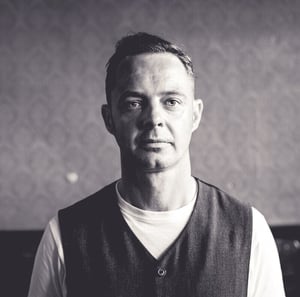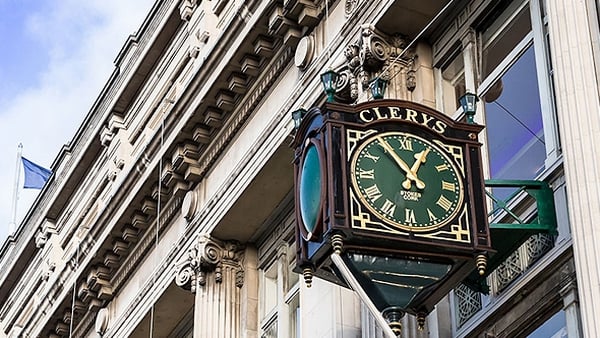Analysis: there are surprising similarities around the challenges the capital city's principal street once faced and what's happening now
A recent episode of Prime Time examined the variety of social and economic problems that have beset the capital's principal street. The programme filmed upsetting scenes of violence, unprovoked attacks on passers-by, and open drug dealing or consumption both on or just off O'Connell Street.
Interviews also made grimly clear that this behavioural pattern on the street has become normalised, while policing and prevention have been insufficient and ineffective. In addition, the feature examined the dilapidated status of the street, particularly the upper end, with many gaps in the eastside block. Other buildings have been shuttered for long periods of time, some for three decades.
We need your consent to load this rte-player contentWe use rte-player to manage extra content that can set cookies on your device and collect data about your activity. Please review their details and accept them to load the content.Manage Preferences
From RTÉ 1's Prime Time, what's gone wrong on Dublin's O'Connell St?
Are the current problems afflicting O’Connell Street and the city centre a new phenomenon, or is there a grim continuity in the patterns of social behaviour on the city’s main streets over time? My research reveals that many of the difficulties facing O’Connell Street today are in fact legacies of the past. However, there are also some surprising similarities and differences to be found.
O’Connell Street became the main street in the capital in the early decades of the 19th century when its previously residential upper core was extended to the river and Carlisle (later renamed O'Connell) Bridge connected it to the south banks of the quays. The shifting of the GPO from College Green to its present location on O’Connell Street largely cemented the street as the de facto commercial heart of Dublin city centre.
The new street was greatly loved and admired by both citizens and visitors for its superior width and length and for the vista of the GPO and Nelson's Pillar. With a new north-south axis carved through the city centre, the street swiftly drew commerce to the area, with the 74 shops present in 1790 increasing to over 300 commercial listings by 1890.
We need your consent to load this rte-player contentWe use rte-player to manage extra content that can set cookies on your device and collect data about your activity. Please review their details and accept them to load the content.Manage Preferences
From RTÉ Archives, architect and historian Sean Rothery takes a walk down Dublin's O’Connell Street in 1986 for Face of the Earth
However, the enormous amount of footfall and prosperity in the area predictably came with a downside. Crime on the street throughout the 19th century was rife, and remarkably similar in nature to what occurs today. Petty crime was a serious problem, with pickpockets a particular scourge.
The newspapers of the period are filled with court reports of more serious crimes. Unprovoked attacks and assaults were common and often fuelled by alcohol. An intoxicated Fergus Nolan was assaulted by two men in broad daylight who struck him and stole his watch on Carlisle Bridge in 1824. In the same year, one Thomas Donaldson was attacked on Halloween night and savagely beaten for no apparent reason by a group of men who knocked him to the ground with sticks and proceeded to jump on his body.
An elderly James O’Brien was drinking in McBride’s pub on Great Britain (Parnell) Street during an afternoon in September 1836. He was being watched by Michael Fagan, a career criminal. Approaching O’Brien, Fagan asked him the time, prompting O’Brien to produce his pocket watch. Having left the pub and crossed O’Connell Street, Fagan followed O’Brien, beat him savagely in an attempt to steal his watch. and attempted to drown his victim in a gutter. Fagan was subsequently charged with attempted murder. Three teenagers were arrested and fined on O’Connell Street in February 1850 for assaulting two women within minutes of each other.
We need your consent to load this rte-player contentWe use rte-player to manage extra content that can set cookies on your device and collect data about your activity. Please review their details and accept them to load the content.Manage Preferences
From RTÉ Radio 1's Ray D'Arcy Show, Nicola Pierce on the life and times of Dublin's O'Connell Street
This is just a flavour of the grim long list of violent incidents associated with O’Connell Street in the 19th century. For much of this time, the street was policed from stations at Sackville Place and Henry Street. Many of the cases reported in the newspapers were based on sentence hearings where the punishments were severe for theft, drunkenness and anti-social behaviour.
In July 1830, Catherine Smith and Theresa Quinn were sentenced to seven months in prison for robbing an English tourist of £100 on O’Connell Street. Working class women were often unemployed and mired in abject poverty, situations which drove them into a life of criminality.
A case in point was the robbery of another man who was relieved of £100 on O’Connell Street. Having reported the theft to Henry Street station, police subsequently rounded up five women sleeping rough in basements at Bow Lane and Barrack Street. Although £30 of the stolen money was returned, the five women were committed to prison.
We need your consent to load this rte-player contentWe use rte-player to manage extra content that can set cookies on your device and collect data about your activity. Please review their details and accept them to load the content.Manage Preferences
From RTÉ Radio 1's Late Debate, does the state of Dublin's O'Connell Street prove that drug policy has failed?
Similarly, Julia Wilson and Anne Clarke were sent for trial in 1836 for a spate of robberies on and around Carlisle Bridge. The pair were observed by a local shopkeeper for some time prowling behind possible victims. Suicides were also tragically common in the area with men and women throwing themselves off Carlisle Bridge.
When we view O’Connell Street today, we must bear in mind that its problems echo the problems of the past. Those who might argue that O’Connell Street today is nothing more than a chaotic, dangerous, dirty bus stop, may be surprised to know that it could also be exactly that in the 19th century, with carriages and later trams replacing today's modern buses and Luas.
However, there are some significant differences between the street today and its earlier incarnation. The most obvious pertain to the residential fabric of the street and the calibre and quality of the commercial units which occupied the thoroughfare. Urban historians classify 'main’ streets as ‘mixed’ streets; that is, to qualify for the term main street, they must contain a combination of residential occupation and an eclectic array of goods and services while not being plagued with derelict or vacant buildings.
We need your consent to load this rte-player contentWe use rte-player to manage extra content that can set cookies on your device and collect data about your activity. Please review their details and accept them to load the content.Manage Preferences
From RTÉ Archives, Kevin O'Kelly reports for RTÉ News from the roof of the GPO on unhappiness on O'Connell Street over road works in 1962
From the late 18th century and well into the 20th, O’Connell Street was both residential and commercial. In 1890, the street contained 107 retail units including clothing stores, shoe shops, piano makers, furniture shops, sporting goods, stationers and bookshops among others.
It was also home to over 200 listed professional services, from chemists and photographers to portrait painters and hairdressers as well as numerous architects, solicitors, banking, commercial and charitable organisations. In addition, the street had 19 hotels, cafés and restaurants. Moreover, the census of 1901 listed 646 residents on O’Connell Street. Urban geographers and historians have emphasised how residential occupation is essential for the vitality of a mixed main street. Non-residential occupation means no local or communal investment in the space.
All of the above is in sad contrast with O’Connell Street today, with its lack of residents and its dubious reliance on low calibre retail and commercial units, multiple casinos, fast food restaurants and convenience stores, while several key spaces remain razed or shuttered. If the above qualification for what constitutes a main street is applied, O’Connell Street lost that status quite some time ago.
We need your consent to load this rte-player contentWe use rte-player to manage extra content that can set cookies on your device and collect data about your activity. Please review their details and accept them to load the content.Manage Preferences
From RTÉ Radio 1's Ray D'Arcy Show, Under the Clock documentary maker Colm Nicell talks about couples who met under the iconic Clery's clock on Dublin’s O’Connell Street, including Kathleen and Peter Cullen
To say that change, improvement or opportunity on the streetscape has been painfully slow, piecemeal and even confusing would be an understatement. A scandalous opportunity is being missed by not turning number 42 Upper O'Connell Street, the last surviving intact Georgian house on the street, into a museum or interactive visitor centre about the past residential history of the street akin to the many house museums in other capital cities. This would fit nicely with the recent metamorphosis of a house on Henrietta Street into a museum dedicated to its tenement past.
Furthermore, the one reasonably recent addition to the street that offered people a place to meet, sit and enjoy a coffee outdoors proved short-lived. Equally loved and loathed, the Anna Livia statue was installed in 1988 but was removed in 2001 because of the difficulty faced by the municipal authorities of removing litter from the fountain.
Every dweller of and visitor to Dublin city centre will tell you that tackling mounting anti-social behaviour is a priority, but this alone will not save O’Connell Street. Neither will shops and restaurants. It might have a chance with a mixed plan of improved residential and commercial units, services, amenities and above all public spaces and interactive cultural experiences managed by the relevant municipal bodies. If the experience of the past tells us anything it is that our principal street will not be resuscitated by yet more reactionary sound bites. It is time for action, not words.
The views expressed here are those of the author and do not represent or reflect the views of RTÉ




